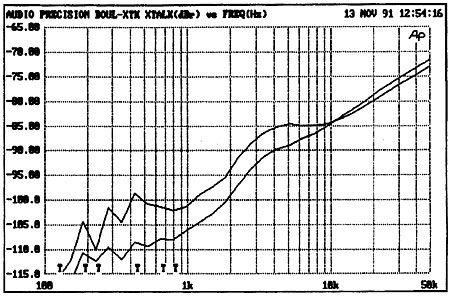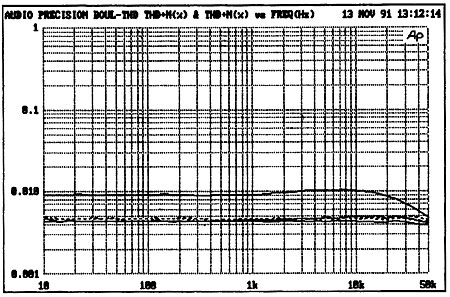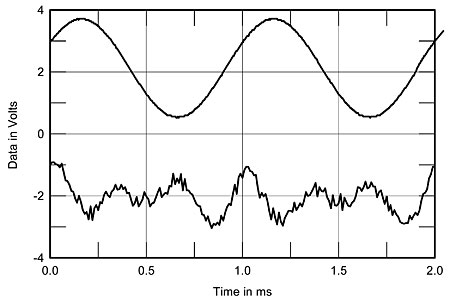| Columns Retired Columns & Blogs |
Boulder 500AE power amplifier Measurements
Sidebar 4: Measurements
Footnote 1: This recommendation was crystalized in AES and American National Standard AES14-1992 (ANSI S4.48-1992), "AES Standard for professional audio equipment—Application of connectors, part 1, XLR-type polarity and gender," published in the JAES, Vol.40 No.1–2, January–February 1992.—John Atkinson
The Boulder's input impedance measured 11k ohms into its balanced inputs (the only type of input furnished on our sample). This is a fairly low figure; care should be taken to insure that the source fed into the 500AE has a low output impedance. The output impedance of the Boulder itself varied between 0.07 ohms and 0.11 ohms, depending on load and frequency, indicating that its frequency response should not vary with the load to any significant extent. Gain into 8 ohms measured 25.97dB at 1kHz, and the S/N ratio was 85dB referenced to 1W into 8 ohms. The DC offset voltage at the Boulder's outputs measured 7mV or less, this inconsequential.
The amplifier is non-inverting provided it is used with a preamp using the same convention for its balanced outputs. Boulder defines pin three of the XLR as the positive or "hot" pin for its balanced input, pin 2 being the negative or "cold." This is the same convention used, for example, by Rowland. But it differs from that used by Threshold, Levinson, and Krell, all of whom, to my knowledge, following the Audio Engineering Society's recommendation in defining pin two as the positive (footnote 1). If you use the 500AE with any of the latter (or any other amplifier using the pin 2/positive convention), it will operate properly, but you must invert the polarity in both channels somewhere else in the system, such as at the loudspeakers, to maintain proper overall absolute polarity.
Fig.1 shows the frequency response of the Boulder 500AE at 2W into 4 ohms, down by 0.5dB at 50kHz. The response for 1W into 8 ohms (not shown) was down by only 0.3dB at 50kHz. The 10kHz squarewave into 8 ohms (fig.2) shows a small degree of rounding of the leading and trailing edges; the 1kHz squarewave (not shown) was nearly perfect. Separation is shown in fig.3, with the top curve (below 10kHz) showing the crosstalk from the left to the right channel, the bottom curve the crosstalk from the right to the left. The decrease in separation at higher frequencies is typical of capacitive coupling between channels. Below 1kHz, the measurement is dominated by noise.

Fig.1 Boulder 500AE, frequency response at 2.83V into 4 ohms (0.5dB/vertical div., right channel dashed).

Fig.2 Boulder 500AE, small-signal 10kHz squarewave into 8 ohms.

Fig.3 Boulder 500AE, channel separation (5dB/vertical div.)
Fig.4 indicates the THD+noise at low power, for 8 ohms (1W), 4 ohms (2W), and 2 ohms (4W). (Bottom to top curves, respectively; solid curves are for the left channel, dotted for the right. The 2 ohm reading was taken for the left channel only.) Note that the 4 and 8 ohm curves are virtually identical, separating only above 1kHz (and then only marginally), while the distortion doubles to a still low 0.009% in the midband into 2 ohms.

Fig.4 Boulder 500AE,THD+N (%) vs frequency at 2.83V into (from bottom to top): 8, 4, 2 ohms (right channel dashed).
Fig.5 shows the THD+noise vs level curves (one channel driven). From bottom to top (referenced at 100W), these are for 8, 2, and 4 ohms respectively. Note that from 7W to about 180W, the 2 ohm distortion is lower than the 4 ohm—an unusual result. The "knees" of the distortion curves fall at approximately 150W, 280W, and 380W into 8, 4, and 2 ohms respectively. Beyond the knee, the sharply rising distortion severely restricts the useful output from the amplifier, although a few more watts are available before reaching the standard 1% distortion level. The latter was reached at 176.3W (22.5dBW) into 8 ohms, 326.6W (22.1dBW) into 4 ohms, and 549W (21.4dBW) into 2 ohms.

Fig.5 Boulder 500AE, distortion (%) vs 1kHz continuous output power into (from bottom to top at 100W): 8, 4, 2 ohms.
With both channels driven, the 500AE produced 168.5W (22.3dBW, left channel) and 167.5W (22.2dBW, right channel) into 8 ohms; 286.3 (21.6dBW, left channel) and 292W (21.6dBW, right channel) into 4 ohms. The AC line voltage during these measurements was 116VAC for the 8 and 4 ohm readings, dropping to 114VAC for the 2 ohms.
Fig.6 shows the response of the Boulder to a 50Hz sinewave at 72W into 4 ohms. The second harmonic is down by approximately 85dB (under 0.01% distortion), and the third harmonic at 150Hz is down about 78dB (just over 0.01% distortion).

Fig.6 Boulder 500AE, spectrum of 50Hz sinewave, DC–1kHz, at 72W into 4 ohms (linear frequency scale).
The result of a combination of 19+20kHz tones fed into the 500AE at 72W into 4 ohms is shown in fig.7. The Boulder is a little less well-behaved than the best amplifiers on this test; some IM distortion products are visible at 18 and 21kHz, both down by about 70dB (0.03% distortion). The THD waveform (bottom trace in fig.8) is heavily third-harmonic overlaid with noise and possibly higher harmonics. It should be noted that this waveform was taken at a level of 143W into 4 ohms—an unusually high figure necessitated by the predominance of low-level noise at lower power output which masked the distortion waveform itself.

Fig.7 Boulder 500AE, HF intermodulation spectrum, DC–24kHz, 19+20kHz at 144W peak into 4 ohms (linear frequency scale).

Fig.8 Boulder 500AE, 1kHz waveform at 2W into 4 ohms (top); distortion and noise waveform with fundamental notched out (bottom, not to scale).
The Boulder 500AE was clearly designed, as JGH stated in his review, to measure well. While that doesn't always translate into a good-sounding product, it is certainly reassuring. In this case, apart from possibly the intermodulation performance—and that is a very slight possibility—I found nothing in the measurements which would in any way detract from JGH's high subjective opinion of the amplifier.—Thomas J. Norton
Footnote 1: This recommendation was crystalized in AES and American National Standard AES14-1992 (ANSI S4.48-1992), "AES Standard for professional audio equipment—Application of connectors, part 1, XLR-type polarity and gender," published in the JAES, Vol.40 No.1–2, January–February 1992.—John Atkinson
- Log in or register to post comments




































